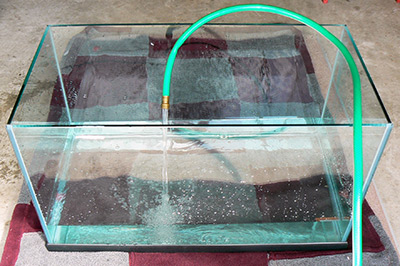Marine aquarium hobbyists can make any number of mistakes when setting up a new system, but some of these errors aren’t as easy as others to rectify after the fact. What follows is a list of five setup errors that are difficult or complicated to correct by the time their consequences become evident:
1. Situating the tank too far from utilities
It should come as no surprise that efficient long-term operation of any aquarium system depends on convenient access to water and electricity. Try to choose a location for your tank that is in reasonable proximity to a water tap, waste drain, and GFCI-protected electrical outlets. Otherwise you’ll end up lugging heavy buckets of water over considerable distances and/or up and down flights of stairs as well as running unsightly extension cords all over the place.
2. Failing to level
Yes, I know that every book or article ever written about setting up an aquarium states that the tank should be leveled before it’s filled with water. But based on experience, I can assure you this is not idle advice. I once had a 29-gallon tank spring a leak (on the morning of a good friend’s wedding, no less) simply because it was out of level from front to back and the water was exerting uneven pressure on the seams. Leveling and shimming an aquarium is an easy chore when the tank is empty, but you should never attempt to do so once it’s full.
3. Forgetting the fill test
Filling an aquarium with fresh water to test for leaks is only important for used tanks, right? Wrong! And again I can speak to this from experience—well, a fellow hobbyist’s experience anyway. About 15 years ago, a friend and I both purchased 75-gallon glass aquariums in the same week, from the same reputable manufacturer, and from the same reputable LFS. I fill tested mine in the garage before setting it up. She didn’t bother. Guess whose brand-new tank sprung a leak in her living room right after it was set up and filled with salt water? (Come to think of it, she probably didn’t level the darn thing either!)
4. Giving only passing thought to the substrate
There are many different options when it comes to the material, grain size, and depth of a marine aquarium substrate, and the best time to make the right choice for your system is not after it’s fully aquascaped and stocked with fish and corals. That’s like completely furnishing a room and then deciding you’re not satisfied with the carpeting. Sure, you can still change it, but what a headache! So give this phase of setup a good deal of thought, factoring in the livestock you plan to keep (e.g., will you have burrowing or sand-sifting fish?), whether you intend the substrate to serve a functional (as in promoting denitrification) or purely aesthetic purpose, etc.
5. Leaving insufficient space around the rockwork
When planning a reef system, it’s all too easy to underestimate how much space corals and other sessile invertebrates will take up in the tank as they grow. If your rockwork consumes too much interior tank space, your corals will be impinging on the glass/acrylic panes in no time, complicating maintenance and greatly restricting swimming space for fish. Remember, negative space plays an important role in aquascaping from both practical and aesthetic standpoints.
What would you add?
Of course, this is only a partial list of potential setup missteps that could create major challenges down the road. So, fellow salties, what would you like to add? Let us know in the comment section below.



